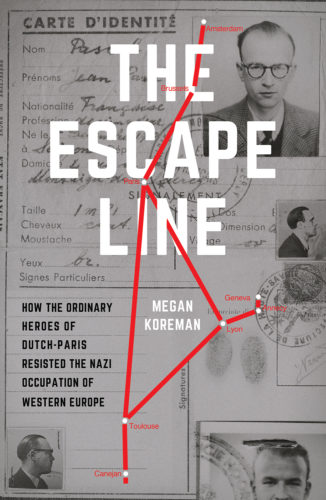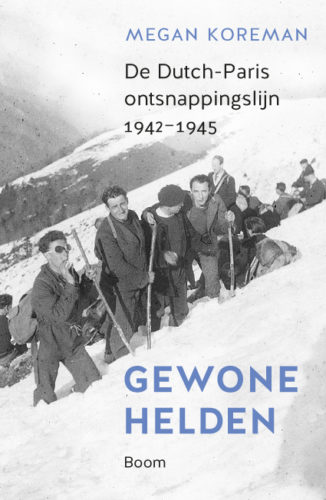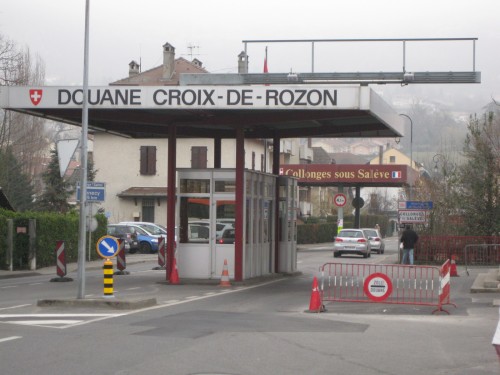Searching for the Dutch-Paris Escape Line
How Not to Look Up the Relatives
Here’s an interesting story from a German reader who is related by marriage to the chief of the Parisian section of Dutch-Paris. We’ll call him Felix.
Felix worked in the Dutch consulate in Paris. His wife, who was also Dutch, had German relatives, one of whom tried to visit them at their home in Paris. This was the uncle of our reader. He spoke French and Dutch and had the family’s address but never managed to visit them because, as the family story goes, someone obstructed his way by sending him off in the wrong direction. It’s not that surprising in hindsight; he was wearing his German uniform.
This must have happened sometime between June 1940 and November 1942 because the German uncle was sent to the Russian Front in 1942, and the German authorities closed the Dutch embassy in Paris in November 1942 and ordered all the diplomats back to the Netherlands. Felix, his wife and three children removed themselves to a hiding place outside of Paris rather than to The Hague. It’s unbelievably unlikely that the relative in the German army would have the address of the hiding place of a family neck deep in the Resistance.
But why, if he had the address, couldn’t this multilingual German soldier find it? Apparently, he didn’t have a map. Of course, the unknown person who misdirected him might have been Felix’s concierge, who had her suspicions about his activities and would have lied to anyone in uniform who came looking for him. Or it could even have been Felix himself, who didn’t know his wife’s German relative but kept his composure when an enemy soldier asked for him in a chance encounter in the street.
But most probably, it was a random passerby who didn’t have any connection whatsoever to Felix but simply gave a German the wrong directions without knowing anything about the German or his destination. Maybe that person made it a policy to send Germans in the wrong direction as a personal act of resistance without ever being part of The Resistance. If so, it was the kind of attitude that made it possible for Resisters to disappear like fish in the ocean of the Parisian population.
Of course, he could equally as well have asked a sympathizer eager to ingratiate himself with the occupying army, or a woman looking for a German boyfriend to help fill the larder. Then that person might have taken him right to Felix’s door, where he may have seen something leading to Felix’s arrest, thus depriving Dutch-Paris of an important leader and compromising the escape and survival of hundreds of people.
History is full of such chances, good and bad, but we don’t usually hear about them. It’s really only chance that we know about this one.
- 0 Comments
- Tags: France
Hiding in Paris vs. Hiding in Lyon
If you plot the known Dutch-Paris addresses for Lyon and Paris on maps, you’ll notice an interesting difference. In Lyon they’re close by each other in the same part of town, but in Paris they’re spread out across the entire city.
All but one of the Dutch-Paris addresses in Lyon lie in what is known as the Presqu’ile, or peninsula, between the Rhone and Saone rivers. A courier coming into Lyon would have arrived at the Perrache train station, walked northward to the grand Place Bellecour and then on into the shopping and residential district, going no more than a few streets further north than the Hotel de Ville. Even a Dutch refugee who’d never been to France before would have been able to find the Dutch Consulate close to Place Bellecour or the Office for Dutch Assistance in the monumental commercial building of the Bourse. It couldn’t have taken John Weidner himself more than half an hour to walk from the train station to his hotel on the rue Sainte Catherine if he was enjoying the window shopping along the way.
But Paris is another story altogether. Evading airmen hid in the basement of the physics laboratories of the Ecole normale superieur in the fifth arrondissement near the Pantheon while the woman who organized their escape lived Read the rest of this entry »
There’s a lot of dull reading involved in historical research, and at the beginning of a project it’s difficult to tell if the letter of complaint about delayed trams is worth noting down or not. After all, it tells you how the trams were functioning, but is that going to be important? It will be if it turns out that “your” people used those trams.
As the research goes on, the outlines of the story begin to emerge and the documents start fitting together. In the case of Dutch-Paris, where the records are scattered over more than a dozen archives in four languages, the documents tend to flow along several paths, only rarely confirming each other directly.
But I had a moment of eerie congruence when I was speaking to the widow of a passeur Read the rest of this entry »
- 0 Comments
- Tags: arrests, Border Crossings
Where to Cross the Border
I had the great honor and privilege to meet a woman who sheltered refugees in her attic on the French side of the Swiss border. Her husband, we’ll call him Jean, smuggled papers over the border for Dutch-Paris on his daily bicycle rides to the university in Geneva. He also guided fugitives over that same border, although by a different path.
Jean’s wife and children very graciously drove me around the border to show me where he crossed the border both openly and covertly. There were two official border crossings that he used regularly until the Italians took away his pass. The photo below shows the border between Croix-de-Rozon, Switzerland, and Collonges-sous-Saleve, France. Jean used to take the line’s mail across there to the post office in Croix-de-Rozon. A French customs official once saved him there by warning him that the Germans were strip-searching everyone in that cream building to the left.
There was also an unofficial crossing point. Read the rest of this entry »
- 0 Comments
- Tags: arrests, Border Crossings, France, Switzerland
Most of the Records went up in Flames
I’ve been looking through the handful of cartons of documents originating from the German police at the Archives nationales in Paris. These are the papers of the SIPO-SD, meaning all the various German policing authorities, both Nazi Party and military, that persecuted Jews, Communists and resisters; passed out travel permits, and kept an eye on industry. It’s an incongruous collection of receipts for requisitioned cutlery, biweekly forms of numbers of arrests made, and internal Gestapo telephone books.
Intriguingly, even if you took the papers themselves out of context, pretending you didn’t know how the Second World War ended, you could tell that the people who wrote these papers both knew that their end was near and refused to believe it.
To begin with, there’s the quality of the paper. Read the rest of this entry »
They Stayed Behind
There isn’t much mystery about why people went to Switzerland or Spain via Dutch-Paris. They were fleeing from the lethal Nazi persecution of the Jews. Or they had been involved in the Resistance but the Gestapo had found their trail. Or they were members of the Allied military, or wanted to fight the Germans alongside it.
The question is more difficult in the cases of people who had every reason to flee, and the connections to do so, but chose to stay behind and help others escape. Of course at some point every resister had a good reason to go underground. Many of the men and women of Dutch-Paris did so while, usually, keeping up their Resistance work. I’m thinking of people who were themselves displaced fugitives who already stood out as refugees but who nevertheless took the added risk of opposition.
Take, for example, the handful of young, Dutch, Jewish men whose families were deported “to the east”. Two of these men literally jumped off the trains that took the rest of their families to Auschwitz. They could have Read the rest of this entry »
- 0 Comments
- Tags: Border Crossings, France, Jews, Switzerland
Wartime Trip Planning
One of the realities of Occupied Europe that’s hard to appreciate from our current perspective is how hard it was to come by information. I’m not talking about reliable news, which was censored. You had to engage in the criminal activity of listening to the BBC or reading the clandestine press for that. I mean the sort of daily information that we take for granted today.
If you’re going on a trip today you simply go on the internet from the comfort of your home to purchase your airline ticket and print out your boarding pass. You can study the train timetables, chose your train and buy your ticket from anywhere in the world that has internet access. You can go on Google maps, put in the address you’ll be leaving from and the address you’ll be going to and choose the best way to get there for the day and time you’ll be traveling by foot, car or public transportation. You can even get photographs of your route.
It was considerably more challenging Read the rest of this entry »
- 0 Comments
- Tags: Border Crossings
One of the more unexpected difficulties I’ve encountered in researching Dutch-Paris has to do with people’s names.
I knew, of course, that it would be difficult to uncover the names of all the members of the line in the first place. Resisters hid their identities; so well that some of them still count as missing persons today because their friends and colleagues who survived didn’t know their true names to report an arrest or death to the family.
But most people did know at least their immediate colleagues’ names, either because they had known them before the war or because they had revealed their true identities to each other afterwards. So in their postwar reports they mention their fellow “illegal workers” by name and, very considerately from my perspective, mention their own noms de guerre.
It is possible, then, to gather up all these names into a semblance of a who’s who of Dutch-Paris. With that, you can go into more archives. Whether it’s the Swiss border patrol or Read the rest of this entry »
- 0 Comments
- Tags: aliases
“I Couldn’t Stand to Hear That.”
Some people ended up in the Resistance bit by bit, because their first act of kindness led to another, that led them to do something else that led onward to something else. That was the case with John Henry Weidner who started out by offering entirely legal assistance to Dutch nationals interned in French camps and ended up leading a multinational rescue operation.
Others propelled themselves deep into illegality without any forethought through the force of their moral outrage. Such was the case with the truck driver and farm wife whose story I quote below. It comes from a collection by the courageous men and women of CIMADE about their efforts to comfort and save the prisoners in the French internment camps, who were mostly Jews. (On occasion Dutch-Paris and CIMADE worked together to rescue particular individuals in danger.)
“One day the young driver of the truck carrying me [Jeanne Merle d’Aubigny] said brusquely, “Do you see that farm? The farmer’s wife did me a great service. Yesterday I had gone to get vegetables in the station at Limoges. While I was loading, I saw a German armored train enter. From the cars came screams, children crying, yells: ‘Papa, Mamma!…’ Mademoiselle, I could not stand to hear that. I backed my truck up to the door of the last car. All the guards were up front. I opened the locks and made a sign to about twenty kids from five to fourteen years old to jump into the truck. In less time than it takes to tell it, they were hidden under the vegetables. I carefully put back the locks and drove around to leave the station. But, what to do with that merchandise? Passing in front of this farm, I asked the advice of that woman. She told me: ‘Unload them here. I’ll take charge then.’ This morning I stopped and asked how it was going. She answered: ‘It’s OK. They are all stowed away in the vicinity.” *
And there you have a community turned into outlaws overnight because they wouldn’t stand aside to allow children to be persecuted.
*Jeanne Merle d’Aubigny and Violette Mouchon, eds. God’s Underground: Accounts of the Activity of the French Protestant Church during the German Occupation of the Country in World War II. Trans. William and Patricia Nottingham. St Louis: Bethany Press, 1970. p. 94.
- 0 Comments
- Tags: concentration camps, France
A Silence of Goodwill
A silent night could be a night of peace or it could be a night of complicity. It could be the silence of not speaking out to help someone in need or the silence of not telling the police where the fugitive is hiding.
You had both types of silence during the war, of course. There were those who shut their own doors tight when others were being hurt. But there were also those who kept silent to protect others, even under torture. That second silence of goodwill is harder to keep, of course, than the narrow silence of self-interest.
But there were those who did keep it, some heroically and others more simply. The heroes could not have survived without the silent complicity of neighbors and by-standers who knew more than they told.
Take, for example, a small town outside Paris that was home to an evasion line for Allied airmen. The group gathered aviators from northwestern France, equipped them and then passed them to other lines for their onward journey to Spain. From December 1943 to March 1944, Dutch-Paris took many of their aviators from Paris to Toulouse.
The local grocer ran the group and found hosts for the Allied airmen. The mayor and a few civil servants from the town hall furnished ration tickets for the aviators. The police commissioner signed their false identity documents. The local tax man himself provided tobacco rations, and the wine wholesaler contributed food and drink. The postmaster arranged for the chief to have a private, unlisted phone line that couldn’t be tapped like everyone else’s.
Surprisingly, although the grocer and his wife and father-in-law were arrested, no one else in the town was. That is a testament to the fortitude of the prisoners under interrogation, but also to the willing complicity of the rest of the community. Because it is impossible that that many people were involved without a great many other people knowing about it.
The aviators and their helpers came and went through that town cloaked by the silence of goodwill.
- 0 Comments
- Tags: Allied airmen, France


